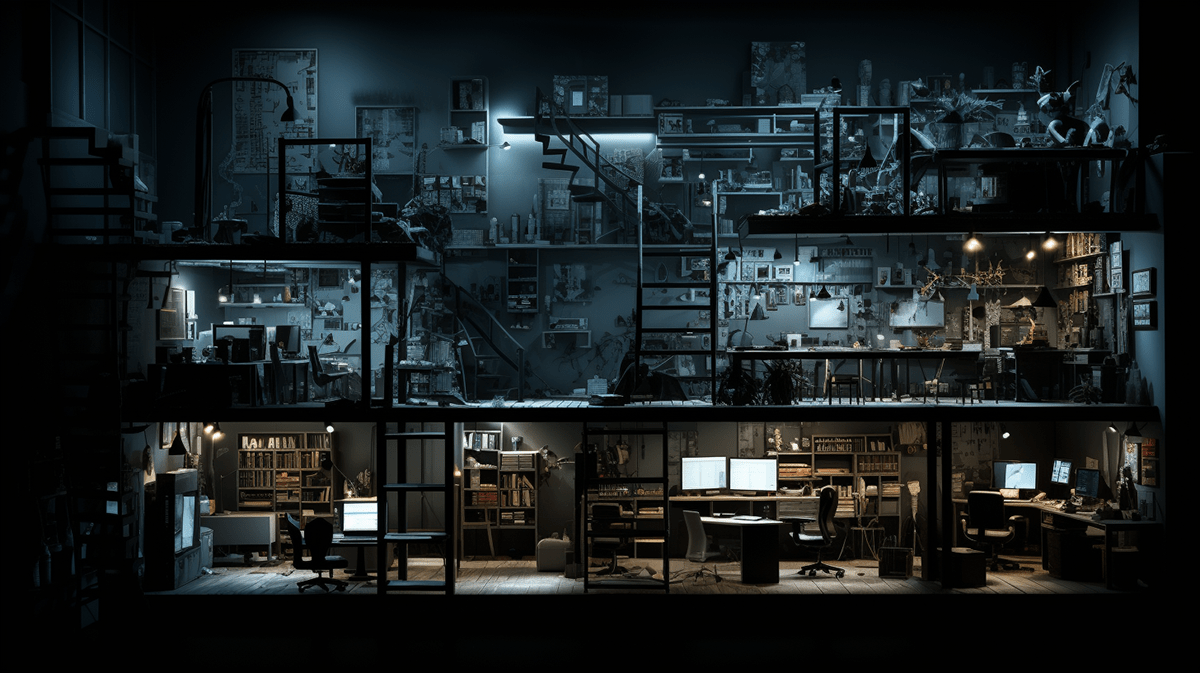This will be the 5th time in 5,209 days that I have put my opinions about taking on extra work outside of your normal job and typically during ridiculous hours of the day and night. This practice has come to be known as “moonlighting” and depending on your age and where you are at in your career, it is either the light at the end of the tunnel or an oncoming train. Andrew and I originally had something else scheduled for today’s show but this topic has been forcing itself into my brain over the past month or so and I want to talk about it . Welcome to EP 149: Moonlighting.
[Note: If you are reading this via email, click here to access the on-site audio player] Podcast: Embed Subscribe: Apple Podcasts | Spotify | Android | iHeartRadio | TuneIn
Today we are going to be talking about moonlighting. I mentioned in the opening that in some capacity, I have brought this topic up for discussion 5 times over the past 14 years but it has never been the focus of a dedicated podcast episode. Is that irony?

Fun Facts jump to 01:52
The etymology of the word “moonlight” as a verb, “hold a second job, especially at night,” and this version or use came into use in 1957 (implied in the verbal noun moonlighting), from moonlighter “one who takes a second job after hours” (1954), from the notion of working by the light of the moon. Earlier the verb had been used to mean “commit crimes at night” (1882), from moonlighter in reference to members of organized bands that carried on agrarian outrages in Ireland.
Did you know there was a phrase called “sunlighting” which is in obvious contrast to the word “moonlighting? “Sunlighting,” as the term indicates, is work done outside the company—but with complete transparency and within the boundaries of what is allowed by professional ethics and individual conscience. sunlighting is considered ethical because it is done transparently after work hours and does not conflict with the employee’s obligations to their primary employer.
The names suggest that moonlighting is done after hours and without the knowledge and consent of your employer while sunlighting is doing essentially the same thing with full disclosure and the approval of your employer.

Experience with Moonlighting jump to 8:39
Andrew and I have both taken on moonlighting jobs in the past, and since I don’t really want to speak for Andrew, I will admit that my experiences fall into both the moonlighting AND sunlighting categories. I’ve also had both positive AND negative experiences. One of the things I tried hard to convey in today’s episode is that I can see both sides of the argument of why moonlighting takes place, it’s value to the individuals, and the benefits that can happen as a result of the extra experience and, and lets be completely blunt about this, the extra money. I bought my first house with moonlighting money … and the client on that job also stiffed me on my completely reasonable bill (I worked without asking for immediate payment for services rendered until the business was up and running and to this date, almost 30 years later, they have never paid me … I should let it go but it provides an extremely valuable life lesson).

Side Effects of Moonlighting jump to 15:58
Originally this was going to be a list of pros and cons, but the pro list was short and incredibly easy to identify. Our conversation on the cons was really about the ramifications – or side effects – or taking on moonlighting work. Without any real effort, the first things that came to mind are:
- Exhaustion
- Burnout
- Decreased productivity
- Health problems
- Getting Fired
These all seem pretty bad to me and came to mind instantly and there is a cascading of effects – meaning, #1 leads to #2 which leads to #3, and so on.
Working long hours can lead to exhaustion and burnout, which can result in decreased productivity, increased errors, and even serious health problems such as heart disease, hypertension, and depression. Moreover, having to juggle two jobs can lead to sleep deprivation, which can impair cognitive function and make it harder to concentrate on tasks.
There was an article I found from the Economic Time [English Edition] titled “Moonlighting: How working a second job can be hazardous for your health and career” but the synopsis of the article was that doctors treated several patients who suffered brain and heart-related ailments due to moonlighting, a practice in which people work for another business of the same niche while being the permanent employees of another. Continuous work and stress can cause heart and neurological issues, anxiety, and depression, and increase the risk of developing mental health disorders.
I have some personal experience with numbers 1 through 3 above, jury is still out on number 4, and so far there isn’t any evidence of #5 being a concern … but I stopped moonlighting architectural projects a long time ago. This blog site and podcast are in some ways a form of moonlighting (although we could use the new term “sunlighting” since there is clearly evidence that everyone knows that I spend time working on this little project of mine, but we dive into that in greater detail in the next section.

Moonlighting = Side Hustle? jump to 30:51
I debated whether or not side-hustles qualified as moonlighting but as a relatively high percentage of people and I feel like it has to be part of the conversation simply because it does contribute to the list of 5 things identified earlier in the show (although, not really number 5 unless things get out of control and it has some sort of bearing on your ability to do the primary job for which you are employed).
Andrew thinks that the difference between moonlighting and side hustle really has to do with the extent of connectivity of that side hustle to your primary job. If you are an architect and in your spare time you make knives or pottery, that is a side hustle. Those of you practicing architecture as your primary job and you’re doing a bedroom addition to your friends house, that is moonlighting.
In my specific case, I have to recognize that my life fundamentally changed based on the work I have put in to this website and now the podcast. Andrew would argue that this is a side hustle but in this regard, I do not agree as “Life of an Architect” is so intertwined with my work and my very existence as an architect. This has been a second job for me since January 2010 and I feel all the ramifications – both positive and negative – of all the work I have put in once my primary job comes to an end and I sit down in front of the computer and start writing and recording content for this website.
To sum this section up, I won’t cast stones at the idea of side hustles, and in some instances, industry-related moonlighting. It changed my life and I can recognize that you can be a good employee and take on additional responsibilities. However, my real job ALWAYS comes first and I do not allow Life of an Architect to ever interfere with my primary job, which means I work a lot of nights and weekends (for example, it’s Sunday morning at 11:16am, I have been at my desk for the last 3 hours, and this post will get published in about 3 hours from now.)

Can Moonlighting Damage Your Career? jump to 39:11
Building off the previous section, and despite the fact that I have benefitted wildly from my side hustle, there are some real ramifications to working excessively. While I believe that side-hustles can actually extend your professional career (leaving your architectural headspace to make fly-fishing lures might actually be a very good thing). However … working on architecture all day to come home and work on more architecture can have a real impact on you. As a result of those “impacts”, here are some things that could become challenged as you exhaust yourself.
Lack of Focus and Reduced Productivity:
Balancing multiple jobs can lead to an increased workload and a divided focus. When you spread yourself too thin, your ability to fully commit and excel in your primary job suffers. The time and energy dedicated to your second job can leave you fatigued, decreasing your overall productivity and diminishing the quality of your work. Employers value employees who demonstrate unwavering dedication and focus on their core responsibilities.
Conflict of Interest:
Engaging in moonlighting can raise concerns about conflicts of interest. Depending on the nature of your second job, there is a risk that it may overlap with your primary employment. This overlap can create ethical and legal complications, compromising your professional integrity and potentially damaging your reputation. Employers expect their employees to prioritize their company’s interests above all else.
Poor Work-Life Balance:
Moonlighting often comes at the cost of a healthy work-life balance. Juggling multiple jobs can leave little time for personal pursuits, relaxation, and self-care. Constantly being on the go and working long hours can lead to burnout and negatively impact your physical and mental well-being. A harmonious work-life balance is crucial for maintaining sustainable career growth and overall happiness.
Limited Career Advancement Opportunities:
Devoting time to a second job may limit your availability for career advancement opportunities within your primary organization. Advancement often requires investing time in developing new skills, taking on additional responsibilities, and demonstrating a commitment to your employer’s goals. Moonlighting can prevent you from dedicating the necessary time and energy to such endeavors, hindering your professional growth and limiting your chances for promotion.
Erosion of Trust and Loyalty:
When employers discover that their employees are moonlighting, it can erode the trust and loyalty between the two parties. Employers may perceive moonlighting as a lack of dedication and commitment, leading to strained relationships. This erosion of trust can have long-lasting effects on your reputation within your industry, potentially resulting in missed opportunities and limited professional networks.
Increased Risk of Mistakes and Burnout:
Working multiple jobs simultaneously can push you to your limits, increasing the likelihood of making mistakes. Fatigue and stress can impair your judgment, reduce attention to detail, and compromise the quality of your work. Additionally, the constant demand to meet deadlines and fulfill obligations from two different jobs can lead to chronic stress and burnout, which can negatively impact your overall well-being and job performance.
Legal and Contractual Implications:
Before taking on a second job, it is crucial to review your employment contract and company policies. Many organizations have strict policies against moonlighting due to the potential conflicts of interest and negative impact on job performance. Engaging in unauthorized moonlighting can result in disciplinary action, including termination. It is important to understand the legal and contractual implications and seek permission from your employer if you are considering moonlighting.
As a good follow up to this portion of the conversation, is the content prepared for the show titled “Workaholic” where we dive into additional issues touching on work/life balance and burnout.
In this article, we discuss “Do Architects actually work a lot of hours?” and “Is being an Architect an 8:00 – 5:00 job?” and “Does Working More Hours Translate into More Money?”
A bit of a deeper dive into what a side hustle is as well as what sort of side hustles lend themselves to architect.

Legal Considerations jump to 46:45
It just makes sense to me that if you decide to take on additional industry-related work outside of your primary job, you should make yourself aware of any potential consequences that exist.
Since we try to be helpful here on the site, there is an article on the AIA Contracts website and is prepared by Diane P. Mika, who is Vice President, Director of Risk Management Education and Andrew D. Mendelson, FAIA, is Senior Vice President and Chief Risk Management Officer of Berkley Design Professional, and it spells out from the employer perspective, a great many things that should be considered when your staff takes on moonlighting work.
This is a good high-level article that articulates the challenges and risks associated with moonlighting work. There is a focus on the do’s and don’ts of moonlighting but there is an additional consideration of how you can’t be a leader in the firm should you choose to take on additional curricular activities. It is worth your time to read and if I wasn’t concerned with plagiarism I would cut and paste it here as an additional convenience.
Would you rather? jump to 57:37

This is a lifestyle question – or a quality of life question and how you perceive the quality of your time.
Would you rather work a 12-hour day with a 10-minute commute or a 6 hour day with a 2-hour commute?
Quick math tells you that the 6-hour day with a longer commute is less time out of your day than a 12-hour day … but what is your state of mind driving 2-hours each way every day?! We’ve also removed the traffic consideration so this is just about sitting in the car for 20 minutes versus 4-hours even though you gain back 2 hours of your day with the longer commute.
Easy choice for both Andrew and me.
Ep 149: Moonlighting
This is a hot topic and isn’t going anywhere. I have been discussing moonlighting for as long as I have been out of college – reviewing what it means, why it’s good, why I hate it, what is the quality of my life, and on and on. I feel like I am in a glass house on this topic so it would be disingenuous for me to talk trash about taking on additional responsibilities. However, I do feel like I am in the perfect position as someone who has benefitted wildly from taking on those additional responsibilities, that when I tell you that I am still on the fence about what I might have sacrificed versus what I have gained that it should be worth paying attention to when deciding which route you would like to go. I will concede that I have more of a second job and the relentless responsibilities present a different sort of grind than the occasional fast burn of taking on a moonlighting gig. Is it worth it? In this case, you really need to weigh your options and go into with your eyes open.
Cheers,

Special thanks to our sponsor Petersen, which manufactures PAC-CLAD architectural metal cladding systems. Visit pac-clad.com to learn more.
